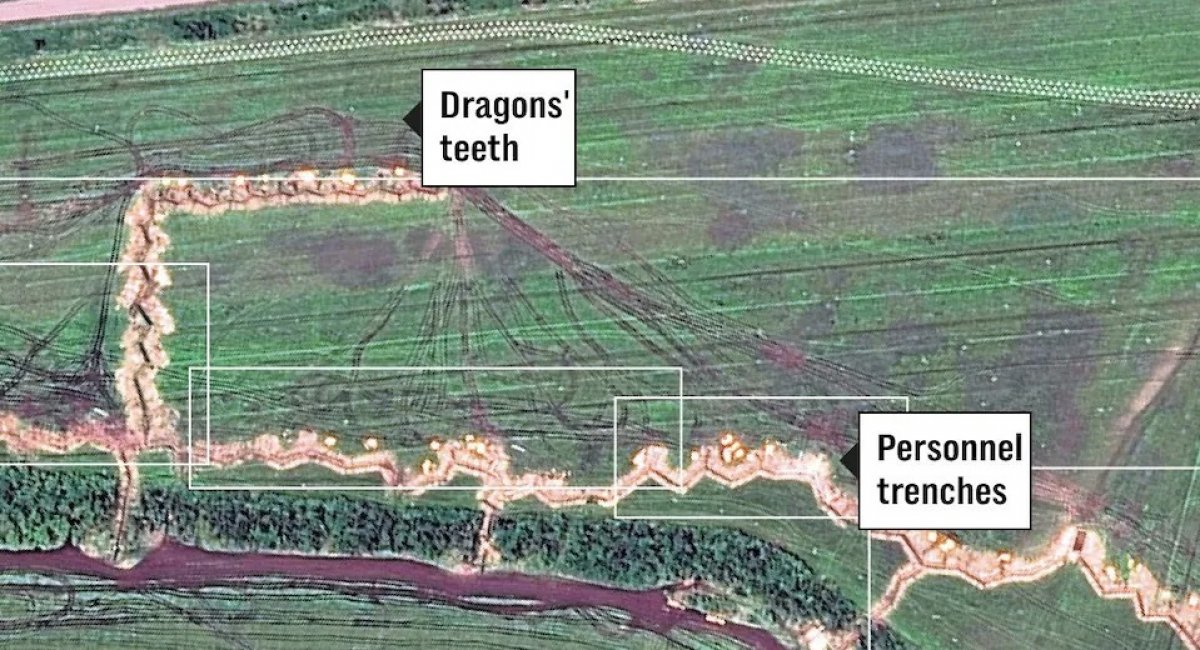Media in Ukraine have started to actively discuss the necessity of building a defense line of fortifications similar to the "Surovikin line" made by the russians to obstruct the Ukrainian counteroffensive in the southern regions. The suggestions come as russian forces actively try to advance on several operational axes in the east of the country.
The fact such ideas gained attention is in itself illustrative since there was quite a lot of mockery toward the "dragon's teeth" and zigzag trenches in the first months of 2023. Just a half year later, the attitude has changed significantly. But here it is important to set the priorities right to not get to a wrong conclusion. A new article by Defence24 will help with that.
Read more: Ukrainian Troops Demonstrate Improved Tactics of Using Tanks, IFVs, APCs on Battlefield (Video)

How the russians Set Their Defenses
Jumping right into their conclusions, the russian "Surovikin line" wasn't the sole or main reason that slowed down the Ukrainian counteroffensive actions, although an important one.
Authors at Defence24 assume that while planning the operation, Ukraine's military command was fully aware of how big of a problem the prepared fortifications were. But the real density of their defense became clear only after the fighting began, and it was bad news for the Ukrainian forces.
For example, the traditional entrenchment in a forest line is actually a whole network of fortifications that is well camouflaged by the surrounding greenery. Quite often, aerial reconnaissance couldn't even see how robust the defense line was underneath all these plants, so Ukrainians had to literally cut them down with artillery or mortar fire just to see it.

When the russians were creating their defense line in the Ukrainian south, they not only erected fortifications made of concrete and soil. They planted mines, too. The minefields combined anti-personnel and anti-tank traps, they were very dense and much wider than an UR-77 Meteorit or an M58 MICLIC system could clear with a single explosive charge.
For comparison: minefields sometimes were 500 meters deep, while the mine-clearing charge can open a passage only up to 120 meters long. In the video below, you can see an example of how the combat engineers from the 36th Marine Brigade neutralized russian minefields with towed M58 MICLICs.
Why Fortifications for Infantry are Important in Modern War
Now, one might wonder, why the Ukrainian Defense Forces won't use armored engineering equipment to overcome the mine barriers. Two important reasons: 1) the amount of demining equipment was not enough, and 2) the russian occupiers, sitting in their protected positions and armed with ATGMs and attack UAVs, immediately began hunting for what few engineering vehicles Ukrainian troops had.
Read more: "Just Drive Around the Minefields: What German Instructors Trained Ukrainians on Leopard 2"
Dense minefields limited the space Ukrainian armored vehicles had for maneuvering, which in turn simplified the job for the russian attack helicopters and artillery. As the losses of armored vehicles increased, the command of the Armed Forces of Ukraine was forced to change the tactics of offensive and switch to the use of small infantry groups with less support from armored vehicles, at least until the way forward was cleared by sapper teams.

This format of warfare not only created additional risk of losses on the Ukrainian side but also put psychological pressure on the Ukrainian soldiers, in particular because of a constant fear of catching a mine. In the meantime, russians felt safe, surrounded by the mines they had planted and fortifications they'd built.
All in all, the conclusion is that in modern warfare, not WW2-style fortifications are the key to an effective defense but a combination of multiple factors, including aerial reconnaissance, mine barriers, concentration of artillery, and so on. On the other hand, heavy and properly fortified positions, prepared in advance, can make the infantry holding them tougher to defeat.

Read more: Ukraine’s Troops Broken Through the russian Defenses Near Robotyne, But the Assault on the "Surovikin line" Will Begin Only Now














